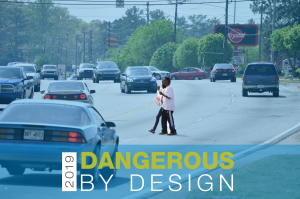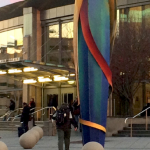New Jersey Future Blog
New Jersey Becoming Less Dangerous for Pedestrians, but Still Work To Do
January 23rd, 2019 by Elaine Clisham
 The 2019 edition of Smart Growth America’s Dangerous By Design report was released today, and overall, the news is good for New Jersey.
The 2019 edition of Smart Growth America’s Dangerous By Design report was released today, and overall, the news is good for New Jersey.
The report analyzes pedestrian fatalities between 2008 and 2017 for every state and the District of Columbia. It highlights where pedestrians are at greatest risk by calculating pedestrian fatality rates per 100,000 population, and what it calls a Pedestrian Danger Index, or PDI, which divides the pedestrian fatality rate by the percentage of commuting trips that are made on foot. Fatality data come from the Fatality Analysis Reporting System (FARS), and population and commute mode share data come from the 2016 American Community Survey.
The good news: New Jersey has done a better job than many states at improving its PDI, which has dropped two points since 2016, better than all but four other states. (Maryland was most improved, with a PDI reduction of 11.9 points, and Delaware saw the biggest increase in PDI of any state, up 24.5 points.)
However, New Jersey had 1.73 pedestrian fatalities per 100,000 people between 2008 and 2017, slightly higher than the national average of 1.55. Its PDI was 54.1, slightly lower than the national average of 55.3. Only 20 states had PDIs higher than the national average, making New Jersey the 21st most dangerous state in the country for. (Florida topped the list with a PDI of 2.73, and Vermont had the lowest PDI at 0.8.)
“Making New Jersey more walkable and bikeable is an important economic, social and environmental goal,” said Peter Kasabach, New Jersey Future’s executive director, “but to reach this goal we must make it safer for all walkers and bikers.”
To reduce PDIs, the report recommends that states and localities:
- Pass and implement robust, actionable Complete Streets policies;
- Set target pedestrian death rates (something every state must do to have access to some federal funds) at levels lower than current fatality rates;
- Prioritize speed reduction and pedestrian safety in street design. Take advantage of new flexibility in federal highway funds and use them to further these goals;
- Test, iterate and scale low-cost design approaches that improve pedestrian safety;
- Replace the “level of service” standard for road design, which prioritizes minimizing vehicle delays, with metrics for safety.
The state of New Jersey has a Complete Streets policy that won a New Jersey Future Smart Growth Award in 2013. In addition, according to the New Jersey Bicycle and Pedestrian Resource Center, eight counties and almost 150 municipalities have enacted Complete Streets policies.
Download the full report and recommendations.
















